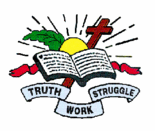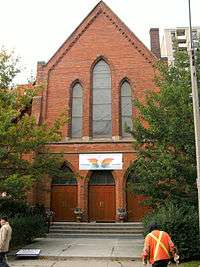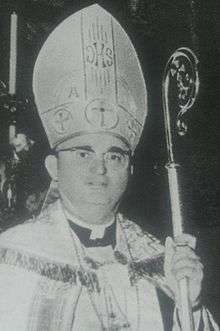Polish National Catholic Church
| Polish National Catholic Church | |
|---|---|
 | |
| Polity | Episcopal |
| Leader | Anthony Mikovsky |
| Associations | Union of Scranton |
| Region | United States, Canada |
| Founder | Franciszek Hodur |
| Origin |
March 1897 Scranton, Pennsylvania, US |
| Separated from | Union of Utrecht |
| Branched from | Roman Catholic Church |
| Congregations | 127 |
| Members | c. 26,000 |
The Polish National Catholic Church (PNCC) is a Christian church based in the United States and founded by Polish-Americans who were Roman Catholic. The PNCC is not in full communion with the Roman Catholic Church; it seeks full communion with the Holy See, although it differs theologically in several important respects. A sister church in Poland, the Polish Catholic Church, is a member of the Old Catholic Union of Utrecht and is also not in communion with the Holy See; at the same time, the PNCC is neither in communion with the Union of Utrecht,[1] but rather the Union of Scranton. The Polish National Catholic Church welcomes people of all ethnic, racial, and social backgrounds.
The church has around 26,000 members in five dioceses in the United States and Canada.[2] The five dioceses are: Buffalo-Pittsburgh, Central, Eastern, Western and Canada.
Beliefs
Worship
The Mass of the Polish National Catholic Church uses one of three liturgies: the Contemporary Rite, the Traditional Rite, and the Rite of Prime Bishop Hodur. The Contemporary is the shortest of the Mass types and the most used in PNCC parishes. It is similar to the current Roman Rite Mass except some parts are from the other two Masses. The Traditional is longer and is still widely used. It is the older Mass used at the time when the PNCC formed. The Prime Bishop Hodur Mass is the longest and filled with additional prayers and litanies, as well as parts of the Traditional Mass.
Eucharist
Following the PNCC's first synod in 1904, the vernacular (first Polish, then English) gradually replaced Latin as the language of the liturgy.
Polish National Catholics believe and accept the doctrine of transubstantiation, that the two species used (bread and wine) become the literal Body and Blood of Christ at the consecration, and also the doctrine of real presence that Christ's body and blood are truly and fully present in the Eucharist. Both doctrines conclude the Mystical Presence of Christ, thus the essence of eucharistic theology is maintained in either doctrine. The consecration takes place during the Canon of the Mass, incorporating both the Words of Institution as spoken by Christ at the Last Supper and the conferring of the Holy Spirit over the elements. Collectively, the bread and wine are believed to become the Body and Blood of Christ by the power of the Holy Spirit. As in the Maronite Church and several other Eastern rite churches, the Eucharist (communion) is given through intinction, whereby the Body of Christ (the host) is partially dipped in the Blood of Christ (the consecrated wine) and then placed on the tongue of the receiver. If only one of the consecrated elements are available or received; either the consecrated wine or bread, the fullness of the Body and Blood of Christ are believed to be present. The clergy will use only the consecrated bread during communion calls outside the church, but still state, "The Body and Blood of Christ" while administering the sacrament. Altar rails are common in PNCC parishes and are used during the distribution of communion.
In preparing for the first reception of the Eucharist (First Communion), education is given from the church's catechism, so that the future recipients will be prepared and understand the experience.
Confession
The PNCC regards a confession of faults to God, followed by the assignment of penance and absolution given by the priest, to be the way the congregation normally obtains forgiveness of sins. The sacrament may be administered in one of two ways: public or private. Private confession is required for all members under the age of sixteen, while public confession is a part of every Mass. In this form, the faithful confess their sins directly and privately to God. The entire congregation then recites the Prayer of Confession. Adults may avail themselves of private confession if they so wish. The PNCC rejects the concept of original sin.[3]
Marriage and divorce
The church believes that "Marriage is the sacrament which makes a Christian man and woman husband and wife, gives them grace to be faithful to each other and to bring up their children in love and devotion to God."[4] Unlike in the Catholic Church, PNCC deacons are not permitted to officiate at weddings. The PNCC permits divorced people to participate fully in the Mass and to receive the Eucharist. The church does not recognise civil divorce and requires an annulment before parishioners can remarry.[3] Every diocese has a matrimonial commission that studies each request for marriage by persons who have been divorced. The commission presents its findings and recommendation to the bishop, who makes the final decision.
Priesthood and marriage
Since 1921 the PNCC has permitted its clergy to be married, and in practice encourages them to be so. They believe that a married priest will have a better understanding of the marital issues facing his parishioners. If a person is unmarried at the time of ordination, he must remain so for a period of two years before entering marriage. The church does not permit women to be ordained either to the diaconate or ministerial priesthood.
Governance
The PNCC is governed in accordance with its Constitution and Laws.[5] Bishops and priests possess the authority to explain and teach the doctrinal position of the church in matters of faith, morals and discipline. The legislative authority of the Church is vested in the General Synod, the Special Synod, the Diocesan Synod and the Parish Meeting. In financial and administrative matters, the parishioners possess administrative authority. Representatives elected at the Annual Parish Meeting, and confirmed by the diocesan Bishop, exercise their constitutional authority in cooperation with the pastor.
The chief legislative body is the General Synod, which normally convenes every four years. The composition of the General Synod includes clergy and laity. Each parish is entitled to send one lay delegate for each 50 active members.[6] While the Constitution and Laws provide that the General Synod holds the authority to remove bishops,[7] the Prime Bishop purported to remove the bishop of the Polish National Catholic Church of Canada in January 2013.[8][9]
History

During the late 19th century many Polish immigrants to the U.S. became dismayed with the hierarchy of the Roman Catholic Church. The U.S. Church had no Polish bishops and few Polish priests, and would not allow the Polish language to be taught in parish schools. The mainly ethnic Irish and German bishops helped establish hundreds of parishes for Poles, but priests were usually unable to speak Polish, and the new immigrants had poor or limited English. There were also disputes over who owned church property, particularly in Buffalo, New York and Scranton, Pennsylvania, with the parishioners demanding greater control. Although the majority of Polish-Americans remained with the Roman Catholic Church, where bilingual Polish-American priests and bishops were eventually ordained, many Polish-Americans in the meantime came to believe that these conditions were a manifestation of "political and social exploitation of the Polish people".[10]
A leader in this struggle was Fr. Franciszek Hodur (1866–1953), a Polish immigrant to the United States and a Catholic priest. Born near Kraków, he emigrated to the U.S. in 1893 and was ordained that year; in 1897, he became pastor of St. Stanislaus Cathedral in Scranton. Continued discontent led to an open rupture with the U.S. Catholic Church in 1897, when Polish immigrants founded an independent Polish body, headquartered in Scranton, with initially some 20,000 members. Fr. Hodur was consecrated as a bishop in 1907 in Utrecht, Netherlands, by three Old Catholic bishops. The PNCC considers him to be the founder and first bishop of the denomination.[11] In 1914 another schism resulted in the formation of the smaller Lithuanian National Catholic Church; it later merged with the PNCC.
From 1907 to 2003, the PNCC was a member of the Old Catholic Union of Utrecht. For much of that period, it was the only member church of the Union based outside Europe (although it was not so when the Philippine Independent Church, also known as the Aglipayan Church, briefly joined the Union of Utrecht).
The Church began missionary work in Poland after the country regained independence following World War I. By the beginning of World War II, the PNCC had founded more than 50 parishes along with a theological seminary in Kraków. During post-war Communist rule of Poland, the Church suffered severe persecution. The Polish Catholic Church is now an autocephalous body in communion with the PNCC.(Mead 1995, p. 222)
Eugene W. Magyar was consecrated on June 29, 1963 as first bishop for Slovak parishes in New Jersey and Pennsylvania. He had served previously as the dean for Slovak parishes in the PNCC from 1958.
In 2002 Robert M. Nemkovich was elected by the twenty-first General Synod to be the sixth Prime Bishop of the Polish National Catholic Church.
In 2010 Anthony Mikovsky was elected by the twenty-third General Synod to be the seventh Prime Bishop of the Polish National Catholic Church. Bishop Mikovsky has been bishop of the Central Diocese and pastor of St. Stanislaus Cathedral since 2006. Before becoming bishop, he served as the assistant pastor at St. Stanislaus, the mother church of the denomination, beginning in 1997.[12]
Ecumenical relationships
The PNCC is a longstanding member of the National Council of Churches and the World Council of Churches.
In the 1970s the PNCC's relationship with the Utrecht Union grew strained as there was a gradual shift towards what was regarded as liberalism in the rest of Utrecht Union churches while the PNCC was becoming more conservative. The PNCC in the United States and Canada entered into a state of "impaired communion" with the Utrecht Union in 1997, since the PNCC did not accept the validity of ordaining women to the priesthood, which most other Utrecht Union churches had been doing for several years. The PNCC continued to refuse full communion with those churches that ordained women; thus, in 2003 the International Old Catholic Bishops' Conference expelled the PNCC from the Utrecht Union, determining that "full communion, as determined in the statute of the IBC, could not be restored and that therefore, as a consequence, the separation of our Churches follows".[13]
For some years the PNCC had inter-communion with the Episcopal Church in the United States (TEC), but in 1978 the PNCC terminated this relationship after TEC's decision to ordain women to the priesthood. In 2004 the cathedral of the PNCC's Canadian diocese, St. John's Cathedral, Toronto, re-established full communion with the Anglican Diocese of Toronto, before being reconciled with the Canadian diocese of the PNCC in 2009.
Although the PNCC has entered into tentative negotiations with Eastern Orthodox Churches in North America, no union has resulted due to the PNCC's substantial adherence to the Catholic view of the sacraments and other issues.
Relations with the Catholic Church improved notably since the 1970s, particularly after the ascension of the Polish-born John Paul II to the papacy.
Dialogue with the United States Conference of Catholic Bishops, with the approval of the Holy See, led in 1996 to an arrangement that Laurence J. Orzell has called "limited inter-communion".[1] What this means is that the Catholic Church recognizes the validity of the sacraments of the PNCC, and allows members of the Latin Church and Eastern Catholic Churches in particular exceptional circumstances, defined in canon 844 of the 1983 Code of Canon Law of the Latin Church and the parallel canon 671 of the Code of Canons of the Eastern Churches, that are regulated by the diocesan bishop or conference of bishops, to receive three sacraments from PNCC ministers. Canon 844 allows those Catholics who can avoid error and indifferentism and are unable to approach a Catholic minister to receive, under certain conditions, the sacraments of Reconciliation, Eucharist, and Anointing of the Sick from "non-Catholic ministers, ministers in whose churches these sacraments are valid", and declares it licit for Catholic priests to administer the same three sacraments to members of churches which the Holy See judges to be in the same condition in regard to the sacraments as the Eastern churches, if they ask for the sacraments of their own accord and are properly disposed.[14] Obstacles to full communion include different understandings about papal primacy, the level of involvement of the laity in church governance, and the PNCC reception of some former Roman Catholic clergy, most of whom subsequently married.[14]
The Nordic Catholic Church was established in Norway in 2000 under the auspices of the Polish National Catholic Church. Since July 2011 the Nordic Catholic Church is an autocephalous member church of the Union of Scranton. Both churches are currently in dialogue with the Free Church of England, a schism from the established Church of England.The PNCC has also taken a former Episcopal church in Italy under its wing.
List of prime bishops
| Numerical order | Reign | Portrait | Name English |
Place of birth |
|---|---|---|---|---|
| 1 | 1904-1953 |  |
Bishop Franciszek Hodur | Zarki, Poland, Austrian Empire |
| 2 | 1953-1968 | Bishop Leon Grochowski | Skupie, Poland, Russian Empire | |
| 3 | 1968–1978 | Bishop Thaddeus Zielinski | ||
| 4 | 1978–1985 |  |
Bishop Francis Rowiński | Dickson City, Pennsylvania, United States |
| 5 | 1985-2002 | Bishop John Swantek | Wallingford, Connecticut, United States | |
| 6 | 2002-2010 |  |
Bishop Robert Nemkovich | United States |
| 7 | 2010–present | Bishop Anthony Mikovsky | Trenton, New Jersey, United States |
See also
- List of the Bishops of the Polish National Catholic Church
- Central Diocese of the Polish National Catholic Church
- Union of Scranton
- St. John's Cathedral (Toronto)
Notes
- 1 2 Orzell, Laurence J. (May 2004). "Disunion of Utrecht". Touchstone Magazine. Retrieved 22 August 2016.
- ↑ Official church website: Who we are
- 1 2 Official Church website: Beliefs and Principles
- ↑ General Synod paper 2002
- ↑ The Constitution and Laws of the Polish National Catholic Church (PDF). Scranton: Polish National Catholic Church. 2006. Retrieved 26 January 2013.
- ↑ Official Church website: Structure
- ↑ The Constitution and Laws of the Polish National Catholic Church (PDF). Scranton: Polish National Catholic Church. 2006. p. 29. Retrieved 26 January 2013.
- ↑ Resolution regarding bp. Sylvester Bigaj, accessed January 25, 2013.
- ↑ Legere, Laura (26 January 2013). "Canadian bishop's removal creates backlash for PNCC". The Citizens' Voice. Retrieved 26 January 2013.
- ↑ (Mead 1995, pp. 220–2)
- ↑ Official Church website: Our Organiser
- ↑ Regional PNCC head elected church's seventh prime bishop
- ↑ "Communiqué of the IBC meeting in Prague/CZ, 2003". Utrechter Union. 29 November 2003. Retrieved 2016-08-22.
- 1 2 Joint Declaration on Unity
References
- ^Note 1 : Encyclopedia of American Religions, J. Gordon Melton, editor. 6th Ed., 1999. pp 93–94.
- Mead, Frank S. (1995), "Polish National Catholic Church of America", Handbook of Denominations in the United States (10th Edition), Abingdon Press, ISBN 0-687-01478-6.
External links
| Wikimedia Commons has media related to Polish National Catholic Church. |
- Official website
- Nordic Catholic Church
- Union of Scranton
- Polish National Catholic Church in the Polish Republic
- Polish Catholic Church (Poland)
- Diocesan and cathedral links
- St. Stanislaus' Cathedral; Scranton, Pennsylvania
- Buffalo-Pittsburgh diocese
- Holy Mother of the Rosary Cathedral; Lancaster, New York
- Canadian diocese
- Western diocese